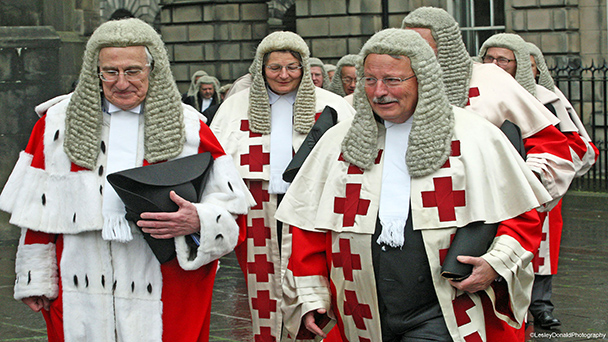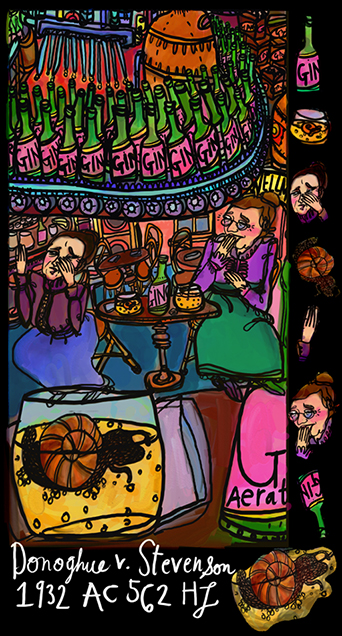1.2 The judgments
To try to find out what the law was, the law lords had to look at the pre-existing cases that made up the common law at the time. The law lords did not agree about whether this specific question raised by Donoghue had already been decided in these cases, or even which cases might be best used to determine what the law is. Consequently they looked at lots of different cases between them, and used a number of different issues to distinguish which cases were most relevant and why.
Lord Atkin gave the leading judgment. Lords Thankerton and Macmillan both added their own comments in their judgments despite agreeing with Atkin’s decision and most of his reasoning. Lord Thankerton’s judgment is quite brief, adding only a couple of points to Lord Atkin’s. Lord Macmillan’s judgment is longer and he considers some of the issues in quite a bit of detail. Lord Buckmaster gave the main dissenting opinion. This was endorsed by Lord Tomlin whose short opinion emphasised a couple of key points as he saw it.
The approaches of the leading and main dissenting judgments by Lords Atkin and Buckmaster are summarised below.
Box 2 Lord Atkin’s leading judgment
Lord Atkin felt that there were no authoritative general statements in the cases of the law in relation to when one person owes a duty to another outside of contract. Instead, the courts had dealt with a number of specific situations and relationships between people in previous cases and had tackled and categorised these individually as they came along. Atkin thought that the law should not be pigeonholed into a number of special classes where a duty was owed. Rather, there must be a general principle that applied to all of the cases based on something that was common among them. He based this first on the idea of the law being required to give remedies for obvious social wrongs. He went so far as to suggest he might not apply case law that denied the claimant a remedy in situations such as Donoghue.
Fortunately, it did not prove necessary for Atkin to disapply precedent case law because he was able to find a general principle in the previous cases upon which the duty of care in delict is based. This is the neighbour principle, which he also derived from the broader moral and social imperative to love your neighbour. Atkin thought the cases that had denied a duty of care involved a more distant relationship between the two parties. There had been no cases dealing with the same situation as in Donoghue that had found there was no duty. To reinforce this, Atkin emphasised the legal rule that only the ratio decidendi in these cases was binding. Any obiter dicta comments that might deny a duty of care were only persuasive (as they did not form part of the ratio decidendi, they were not binding on subsequent cases) and were often drawn too widely.
Atkin distinguished a number of cases that might have been seen as analogous. He claimed that these cases were only about the duty of care under a contract, or fraud (where the manufacturer knew of a product defect), rather than negligence. He also did not think that the law had, so far, only allowed exceptions to the general rule that there was no duty of care in certain, specific circumstances involving inherently dangerous objects (such as a gun) and physical proximity (where, for example, the person injured was on the property of the person who owed the duty of care). Atkin saw these alleged ‘exceptions’ as examples of a wider concept of negligence, rather than the only instances where a duty was enforced. He was able as a result to at least claim he was following the cases rather than introducing a new principle into the common law.
Box 3 Lord Buckmaster's dissenting judgment
Lord Buckmaster adopted an almost completely opposite interpretation of the existing cases to Lord Atkin. He argued that the general rule was that there was no duty of care owed to a third party outside of a contract. The exceptions to this were for objects dangerous in themselves (such as a gun) and defects that were known to the manufacturer (fraud). He then dealt with the very few cases, mainly with obiter dicta statements, which might be seen to support a duty of care in other cases such as that in Donoghue. While he thought some of these could be used to impose a duty of care on Stevenson, he also considered them contrary to the clear line of decisions and felt they ‘should be buried so securely that their perturbed spirits shall no longer vex the law’ (Donoghue v Stevenson [1932] AC 562). He saw those cases where physical proximity was involved as belonging to a clearly different category and argued that the established distinction between dangerous and non-dangerous objects in the case law would be ‘meaningless’ if the duty of care existed all along in both cases. He also said the logical consequences of imposing a duty would extend to all types of objects and to all people who lawfully used them. In this, Buckmaster implied it would not be socially or economically acceptable for manufacturing businesses to be open to claims from such a wide group of people as if a duty was imposed.
These two contradictory interpretations and applications of the pre-existing case law raise a number of questions about the process of reasoning used to come to each judgment. You consider some of these in the following section.

